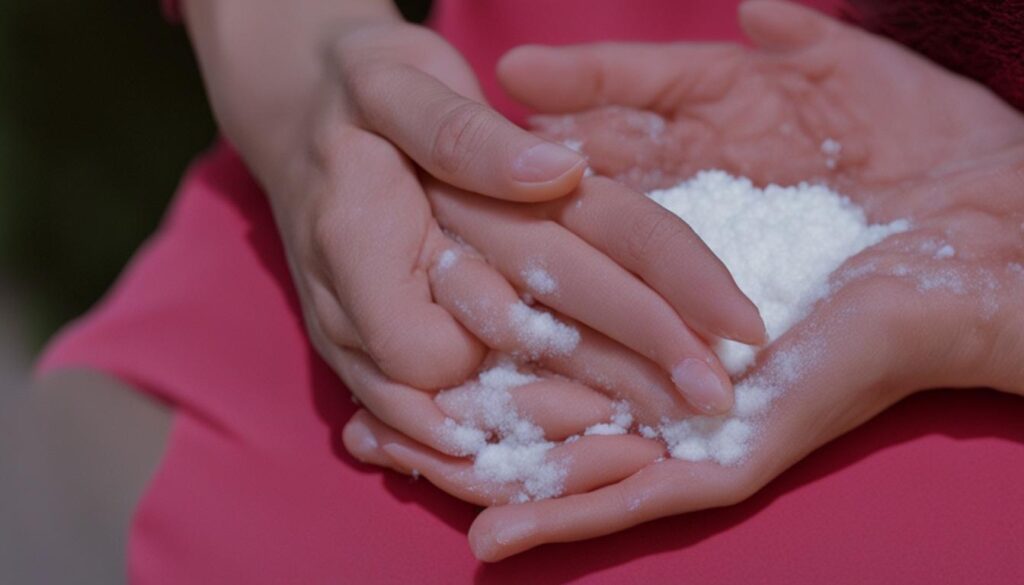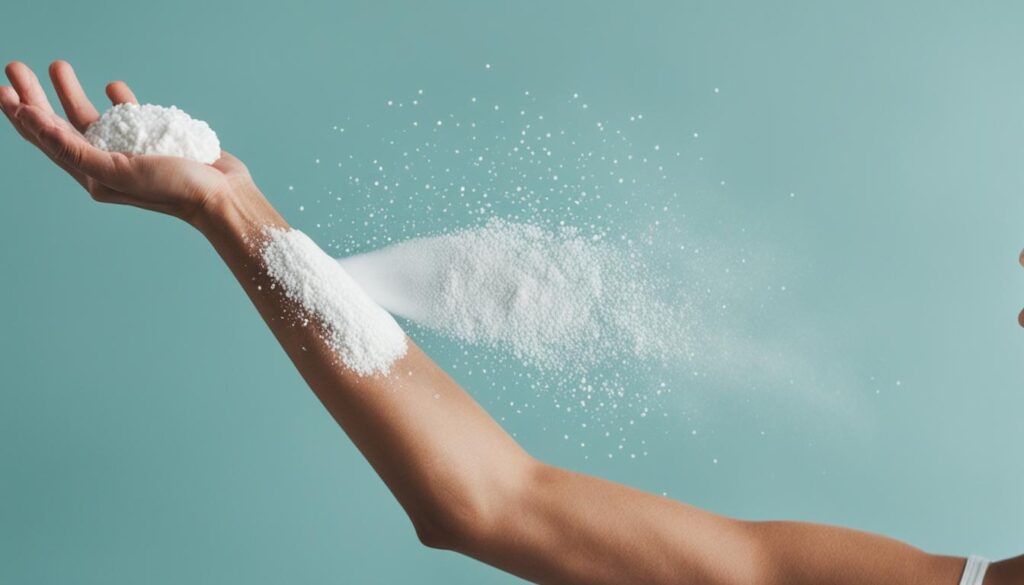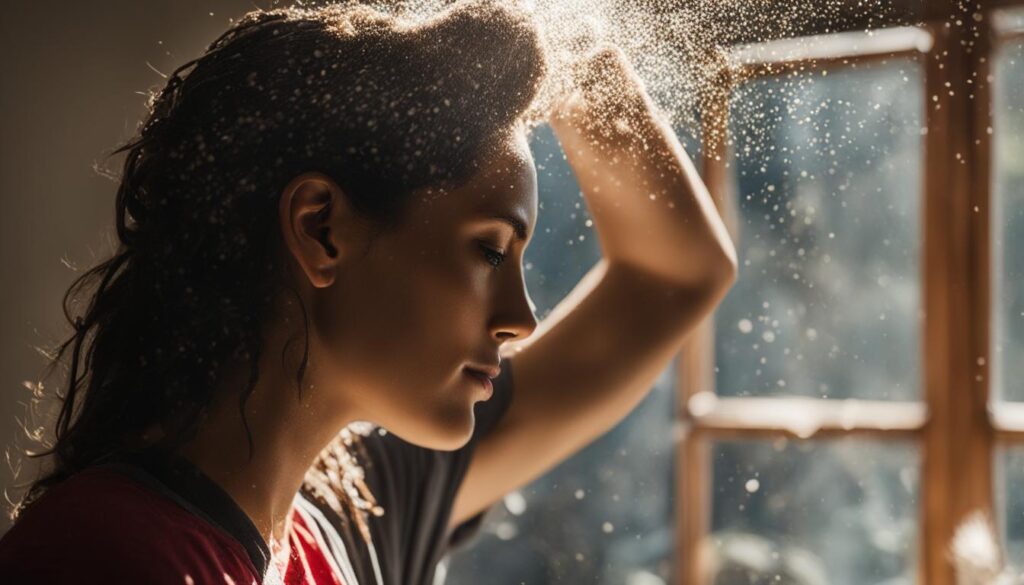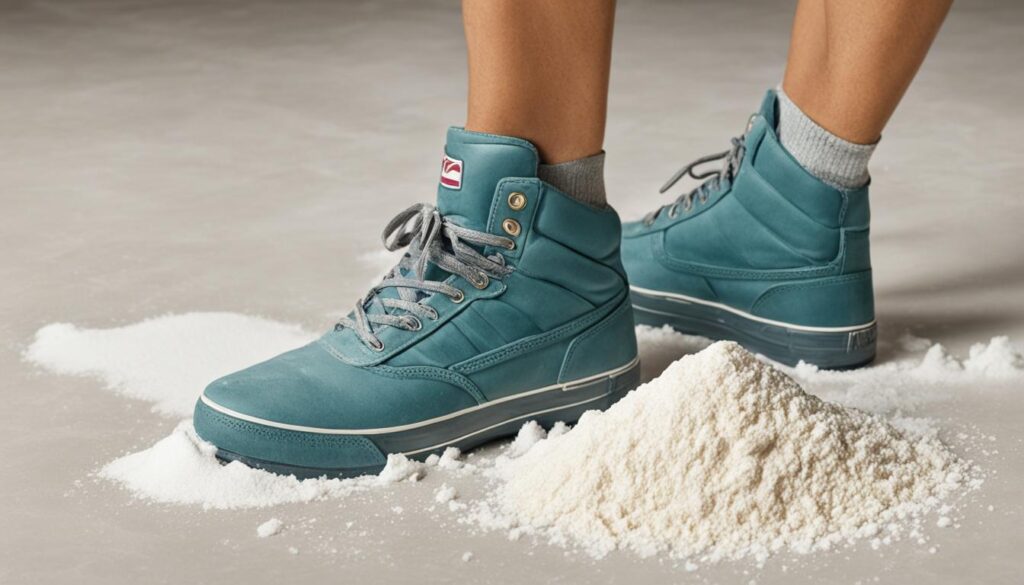Welcome to my article on the uses and benefits of cornstarch! In this piece, I will share with you the various ways in which cornstarch can be utilized in cooking, skincare, household chores, and more. With its versatile nature and numerous applications, cornstarch is a must-have ingredient that can elevate your culinary creations and provide relief in various situations.
As a common thickening agent, cornstarch is widely used in cooking to enhance sauces, soups, and gravies. It is also an essential ingredient in baking, allowing you to achieve light and fluffy textures in cakes, cookies, and other baked goods. Its ability to thicken and stabilize makes it a valuable tool in the kitchen.
But cornstarch is not limited to the culinary realm. It has several other remarkable uses that you might not be aware of. For example, did you know that cornstarch can be used for skincare? It offers relief for skin irritation and can help soothe sunburned skin. By applying cornstarch topically, you can reduce itchiness and promote comfort.
In addition to skincare, cornstarch can also be utilized as a natural deodorant. Its moisture-absorbing properties make it an excellent choice for decreasing sweat and odor. You can easily create your own DIY cornstarch deodorant using simple ingredients like coconut oil and baking soda.
Another surprising use for cornstarch is as a dry shampoo. When you’re in a rush or unable to wash your hair, applying cornstarch to the roots can help absorb excess oil, revitalizing your hair and giving it a fresh look. It’s a handy trick to keep in mind for those busy days.
Cornstarch has even found its way into household chores. It can be used as a stain remover, carpet freshener, and silverware polisher. Additionally, it can help untie stubborn knots, remove grease spatter from walls, and clean stuffed animals and fabrics. Its versatility knows no bounds!
But that’s not all— cornstarch can also be beneficial in preventing athlete’s foot by reducing moisture in shoes and socks. By sprinkling cornstarch in your footwear or applying it to your socks, you can help prevent fungal growth and maintain dryness. It can also be used to alleviate the itchiness caused by bug bites and provide relief for blisters by reducing friction.
Lastly, cornstarch can even be incorporated into your beauty routine. It can help detangle hair knots, giving you smoother and more manageable tresses. Additionally, it can be used to create a trendy matte nail polish effect by mixing it with regular nail polish.
Key Takeaways:
- Cornstarch is a versatile ingredient used as a thickening agent in cooking and baking.
- It can be used topically to soothe skin irritation and relieve sunburn.
- Cornstarch can act as a natural deodorant and dry shampoo.
- It has various household uses, including stain removal and fabric cleaning.
- Cornstarch can help prevent athlete’s foot and provide relief for bug bites and blisters.
Cornstarch for Skin Relief

Cornstarch is not just limited to culinary applications; it also offers numerous benefits for skincare. This natural ingredient can be used as a remedy for soothing skin irritation and relieving sunburn. Let’s explore how cornstarch can provide relief for common skin concerns.
Relieving Skin Irritation
For those dealing with skin irritation, cornstarch can be a gentle and effective solution. Its fine texture and moisture-absorbing properties make it ideal for reducing itchiness and discomfort. You can create a simple cornstarch paste by mixing cornstarch with water and applying it directly to the irritated area. Leave it on for a few minutes before rinsing it off with lukewarm water. The soothing properties of cornstarch can provide the much-needed relief your skin deserves.
Soothing Sunburn
After spending a day under the sun, sunburn can leave your skin red, tender, and painful. Cornstarch can help alleviate the discomfort associated with sunburn. Its cooling and drying properties can provide relief by reducing redness and soothing the affected area. Simply mix cornstarch with water to create a paste and apply it gently to the sunburned skin. Let it sit for about 15 minutes before rinsing it off. The cornstarch paste can help alleviate the burning sensation and promote healing.
Reducing Friction on the Skin
Cornstarch is not only beneficial for direct skin application but can also be used to reduce friction between the skin and clothing or bedding. Simply dust a small amount of cornstarch on sheets, clothing, or other areas where friction can occur. This can be particularly helpful for individuals with sensitive skin or those who experience discomfort due to chafing. The silky texture of cornstarch can minimize friction and provide a more comfortable experience throughout the day or night.
Cornstarch as a Deodorant

When it comes to finding a natural and effective deodorant, cornstarch is a surprising hero. Thanks to its moisture-absorbing properties, cornstarch can help decrease sweat and odor, making it a popular ingredient in DIY deodorants.
To create your own DIY cornstarch deodorant, you’ll need a few simple ingredients:
- 1/4 cup cornstarch
- 1/4 cup baking soda
- 4 tablespoons coconut oil
- 10-15 drops of your preferred essential oil (such as lavender or tea tree oil)
Mix the cornstarch and baking soda together in a bowl. Then, add the coconut oil and essential oil drops. Stir until well combined.
Note: Some people may find that baking soda causes skin irritation. If this is the case for you, you can reduce the amount of baking soda or omit it altogether.
To use this DIY cornstarch deodorant, simply apply a small amount to clean, dry underarms. The cornstarch helps absorb moisture, while the baking soda neutralizes odor. Coconut oil provides a smooth consistency and moisturizes the skin, while essential oils add a pleasant scent.
Keep in mind that cornstarch deodorants may not provide as much long-lasting odor protection as commercial deodorants or antiperspirants. However, they can be a great option for those looking for a natural solution or for individuals with sensitive skin who may react to certain ingredients in commercial products.
Quote: “I’ve been using a DIY cornstarch deodorant for months now, and I love how gentle and effective it is. It keeps me feeling fresh and confident throughout the day.” – Sarah Thompson, Natural Beauty Enthusiast
So why not give cornstarch a try as a natural deodorant? Not only can it help control perspiration and odor, but it also allows you to customize your deodorant with your favorite scents.
Next, let’s explore another surprising use for cornstarch – as a dry shampoo.
Cornstarch as Dry Shampoo

When it comes to hair care, cornstarch might not be the first ingredient that comes to mind. However, this versatile pantry staple can double as a natural dry shampoo, allowing you to extend the time between washes and keep your locks looking fresh.
As a dry shampoo, cornstarch works by absorbing excess oil from the scalp, which is the primary culprit behind greasy hair. By applying cornstarch to the roots of your hair and brushing it through, you can effectively soak up the oil, giving your hair a refreshed appearance.
One of the benefits of using cornstarch as a dry shampoo is its natural formula. Unlike commercial dry shampoos that often contain harsh chemicals, cornstarch is a gentler alternative that is suitable for most hair types, including sensitive scalps.
Not only does cornstarch absorb oil, but it also adds volume to the hair, making it look fuller and more voluminous. This can be particularly beneficial for those with fine or thin hair who struggle with flatness.
If you’re concerned about the white residue that can sometimes be left behind when using cornstarch as a dry shampoo, don’t worry! One way to prevent this is to mix the cornstarch with a small amount of cocoa powder or a shade closer to your hair color. This will help blend the product seamlessly into your hair.
Here’s a step-by-step guide on how to use cornstarch as a dry shampoo:
- Start by parting your hair into sections.
- Sprinkle a small amount of cornstarch onto the roots of each section, focusing on the areas that tend to get oily.
- Use a brush or your fingers to gently massage the cornstarch into your scalp, distributing it evenly.
- Wait for a few minutes to allow the cornstarch to absorb the excess oil.
- Brush your hair thoroughly to remove any remaining residue.
Remember, while cornstarch can be a convenient and cost-effective alternative to traditional dry shampoos, it may not work for everyone. It’s essential to experiment and find the right amount for your hair type and desired results.
Benefits of Cornstarch as a Dry Shampoo:
| Benefits | Explanation |
|---|---|
| Natural Ingredient | Cornstarch is a natural alternative to commercial dry shampoos, reducing exposure to harsh chemicals. |
| Absorbs Excess Oil | Cornstarch effectively absorbs oil from the scalp, refreshing the hair between washes. |
| Adds Volume | The natural texture of cornstarch gives the hair a fuller, more voluminous appearance. |
| Cost-Effective | Cornstarch is an affordable option compared to commercial dry shampoos. |
So, the next time you’re in a rush or simply want to give your hair a break from washing, consider reaching for cornstarch as a convenient and natural dry shampoo option. It’s a simple and effective way to keep your hair looking fresh and clean between washes.
Other Household Uses for Cornstarch
While cornstarch is commonly known for its culinary uses, it also has a range of practical applications around the house. Let’s explore some of the ways you can utilize cornstarch for household tasks, from cleaning to ironing.
Stain Remover
Cornstarch can be an effective stain remover for both fabric and carpet. To remove stains, sprinkle cornstarch onto the affected area and let it sit for a few minutes. Then, brush or vacuum it away. The cornstarch helps absorb moisture and lift the stain, leaving your fabrics fresh and clean.
Carpet Freshener
If your carpets are starting to emit unwanted odors, cornstarch can come to the rescue. Sprinkle a generous amount of cornstarch over your carpet, leave it for at least 30 minutes, and then vacuum it up. The cornstarch will absorb odors, leaving your carpets smelling fresh and clean.
Silverware Polisher
Bring back the shine to your silverware using cornstarch. Create a paste by mixing cornstarch with water, and apply it to your tarnished silverware. Gently rub the paste onto the silverware using a cloth or sponge, then rinse and dry thoroughly. The cornstarch helps remove tarnish and restore the luster of your silverware.
Starch for Ironing Clothes
Cornstarch can be used as a natural starch substitute for ironing clothes. Mix cornstarch with water to create a paste, then add the mixture to a spray bottle. Lightly mist your clothes with the cornstarch solution before ironing. The cornstarch helps to stiffen the fabric and gives it a crisp, professional finish.
Untie Knots
We’ve all experienced the frustration of trying to untangle stubborn knots. Cornstarch can make the process easier. Apply a small amount of cornstarch to the knot and work it into the fibers. The cornstarch acts as a lubricant, allowing the fibers to slide more easily and helping you untie those pesky knots.
Remove Grease Spatter from Walls
Cornstarch can be used to remove greasy spatter from walls in your kitchen. Create a paste by mixing cornstarch with water, then apply it to the affected area using a cloth or sponge. Gently scrub the grease spatter, and then wipe clean with water. The cornstarch absorbs the grease, leaving your walls clean and spotless.
Clean Stuffed Animals and Fabrics
Stuffed animals and fabrics can accumulate dust and dirt over time. Give them a refresh by using cornstarch. Sprinkle cornstarch over the surface of the item, allowing it to sit for a few minutes. Then, brush off the cornstarch using a soft brush or cloth. The cornstarch helps absorb dirt and oils, leaving your items clean and revitalized.
By utilizing cornstarch for these household tasks, you can take advantage of its natural properties to tackle everyday chores effectively. Whether you’re freshening up your carpets or ironing your clothes, cornstarch can be a handy and versatile ingredient in your household cleaning routine.
Benefits of Cornstarch for Athlete’s Foot Prevention

Cornstarch is not only a versatile ingredient in the kitchen but also a helpful remedy for preventing athlete’s foot and combating foot odor. Its moisture-absorbing properties make it an effective solution for reducing moisture in shoes and socks, creating an inhospitable environment for fungal growth. By incorporating cornstarch into your foot care routine, you can keep your feet dry and fresh, preventing the development of athlete’s foot and unpleasant odors.
To utilize cornstarch for athlete’s foot prevention, there are a few simple methods:
- Sprinkle cornstarch in your shoes:
- Apply cornstarch to socks:
Before wearing your shoes, sprinkle a small amount of cornstarch inside them. The cornstarch will help absorb excess moisture, keeping your feet dry and preventing the growth of fungi.
Prior to putting on your socks, gently dust them with cornstarch. This will create a layer of moisture absorption between your feet and the fabric, reducing the likelihood of sweat accumulation that can lead to athlete’s foot.
In addition to its preventive benefits, cornstarch can also be used as a remedy for foot odor. The moisture-absorbing properties of cornstarch help control the bacterial growth responsible for odor development, leaving your feet fresh and odor-free.
Expert Insight:
“Cornstarch can be a helpful tool in preventing athlete’s foot. By reducing excess moisture, it creates an environment where fungus is less likely to thrive. Incorporating cornstarch into your foot care routine can be a simple and effective way to keep your feet healthy and odor-free.” – Dr. Sarah Johnson, Podiatrist
By harnessing the power of cornstarch, you can proactively protect your feet from the discomfort of athlete’s foot and the embarrassment of foot odor. Incorporate cornstarch into your daily foot care routine to enjoy the benefits of its moisture-absorbing properties.
Cornstarch for Bug Bite Relief

If you’ve ever been bothered by the itchiness of bug bites, you’ll be delighted to know that cornstarch can provide much-needed relief. Its soothing properties can help alleviate the discomfort caused by mosquito bites, bee stings, and other insect irritations.
One effective way to use cornstarch for bug bite relief is by creating a simple paste:
Making a Cornstarch Paste
- In a small bowl, mix equal parts cornstarch and water to form a smooth paste.
- Apply the paste directly to the affected area, covering the entire bug bite.
- Leave the paste on for about 15 minutes to allow it to dry and absorb any excess moisture.
- Gently wash off the paste with warm water and pat the area dry.
The cornstarch paste helps to soothe the itchiness and reduce inflammation caused by bug bites. It creates a protective barrier on the skin, preventing further irritation and allowing the bite to heal more quickly. This natural remedy can be especially handy during outdoor activities or while traveling.
When using cornstarch for bug bite relief, it’s essential to keep in mind any bugs or insects that might have transmitted diseases. If you experience severe or prolonged symptoms, it’s important to seek medical attention.
Here’s a closer look at the process:
| Step | Description |
|---|---|
| 1 | |
| 2 | Mix equal parts cornstarch and water to create a paste. |
| 3 | Apply the paste to the affected area. |
| 4 | Leave the paste on for about 15 minutes. |
| 5 | Rinse off the paste with warm water and pat dry. |
With cornstarch’s natural ability to relieve itchiness and reduce inflammation, it can make a significant difference in your comfort level when dealing with bug bites. Give this simple and affordable remedy a try the next time you experience the annoyance of bug-related irritations.
Cornstarch for Blisters

When it comes to blisters, cornstarch can be a game-changer. Not only does it help reduce friction, but it also provides much-needed relief to the affected area. By applying cornstarch to the blister, you can effectively minimize friction and keep the area dry, promoting healing and preventing further discomfort. However, it is essential to note that cornstarch should not be applied to open blisters or wounds, as it may increase the risk of infection.
To use cornstarch for blisters:
- Clean the blister and the surrounding area with mild soap and water.
- Pat the area dry gently with a clean towel.
- Apply a thin layer of cornstarch directly onto the blister. Ensure it covers the entire affected area.
- Cover the blister with a sterile adhesive bandage or dressing to protect it.
- If necessary, repeat the process two to three times a day until the blister heals.
Please remember that cornstarch is not a substitute for proper medical care. If your blister shows signs of infection, such as increased redness, swelling, or pain, it is crucial to seek medical attention.
| Pros | Cons |
|---|---|
| Reduces friction | Should not be applied to open blisters or wounds |
| Provides relief | Not a substitute for medical care |
| Keeps the area dry |
Note: The table above summarizes the pros and cons of using cornstarch for blisters.
When it comes to managing blisters, cornstarch can be a useful tool in your arsenal. Its ability to reduce friction and provide relief can help alleviate discomfort and promote healing. However, it is essential to use cornstarch responsibly and seek medical attention if necessary. Stay proactive in taking care of your skin, and consider incorporating cornstarch into your blister care routine.
Cornstarch for Detangling Hair Knots

When it comes to dealing with hair knots and tangles, cornstarch can be a handy and natural solution. Its unique properties make it effective in reducing friction and lubricating hair fibers, making the detangling process much easier.
To use cornstarch for hair knots, simply follow these steps:
- Start by identifying the area with the hair knot.
- Take a small amount of cornstarch and sprinkle it onto the knot.
- Gently work the cornstarch into the knot, using your fingers or a wide-toothed comb.
- Continue to work through the knot, gradually loosening it as the cornstarch helps to reduce friction.
- Once the knot has been loosened, you can easily comb through the hair to fully detangle it.
This simple method can save you from the frustration of stubborn hair knots and minimize the risk of hair breakage or damage. Whether you’re dealing with a minor tangle or a more intricate knot, cornstarch can be a gentle and effective tool in your hair care routine.
Remember, it’s always important to be gentle and patient when detangling your hair, as excessive tugging or pulling can lead to further damage. By incorporating cornstarch into your detangling routine, you can make the process smoother and more manageable.
Next, let’s take a look at the benefits of using cornstarch for creating matte nail polish, another versatile use of this incredible ingredient.
Testimonial
“I have fine, easily tangled hair, and cornstarch has been a game-changer for me. It’s amazing how it reduces the friction and helps me detangle without any pain or breakage. I highly recommend giving it a try!”
| Advantages | Disadvantages |
|---|---|
| – Reduces friction in hair knots | – May leave a white residue if not properly brushed out |
| – Lubricates hair fibers for easier detangling | – May not be effective for extremely severe knots |
| – Natural alternative to chemical detangling products | – Requires additional brushing or combing to fully remove the cornstarch |
Cornstarch for Matte Nail Polish
Looking to achieve a trendy matte nail polish effect? Look no further than cornstarch! With just a few simple steps, you can transform your regular nail polish into a gorgeous matte finish.
Here’s a quick and easy DIY method to create your own matte nail polish using cornstarch:
- Start by applying a base coat of your favorite nail polish color and allow it to dry completely.
- In a separate container, mix a small amount of cornstarch with your chosen nail polish shade.
- Stir the mixture thoroughly until the cornstarch is well incorporated into the polish, creating a smooth consistency.
- Apply the cornstarch-infused polish to your nails, ensuring an even and thin layer.
- Allow the nails to dry completely, giving the cornstarch time to settle and create the desired matte effect.
- Finish off with a top coat to seal in the color and enhance its longevity.
This simple technique allows you to experiment with different nail polish colors and create a customized matte look that is stylish and on-trend.
Not only does cornstarch offer a cost-effective way to achieve a matte finish on your nails, but it also allows for creativity and versatility in your nail polish collection.
Try this DIY cornstarch method today and enjoy beautiful matte nails that are sure to make a statement!
Benefits of Cornstarch for Matte Nail Polish
Using cornstarch to create a matte nail polish finish comes with several advantages:
- Cost-effective: Cornstarch is an affordable and easily accessible ingredient that can save you money compared to purchasing matte nail polish products.
- Customizable: By mixing cornstarch with different nail polish shades, you can create unique matte colors and experiment with various combinations.
- Versatile: Cornstarch can be used with any nail polish brand or formula, allowing you to achieve a matte finish with your preferred products.
- Temporary: Unlike traditional matte nail polishes, the cornstarch method allows you to easily switch back to a glossy finish by applying a shiny top coat.
Give your nails a chic and matte look with this simple DIY technique using cornstarch!
Best Quality Selection and Storage of Cornstarch
When it comes to using cornstarch in your cooking and baking, selecting a high-quality product is essential. Opting for a reputable brand ensures that you are getting a reliable and consistent product that will deliver the desired results.
It is recommended to store cornstarch in a cool, dry place to maintain its freshness and quality. Direct sunlight and moisture can affect its texture and effectiveness, so it’s important to keep it away from these elements. By storing cornstarch properly, you can prolong its shelf life and preserve its thickening properties.
Here are some key guidelines for storing cornstarch:
- Place cornstarch in an airtight container to prevent moisture absorption and keep it free from contaminants.
- Avoid storing cornstarch near strong-smelling substances as it can easily absorb odors.
- Store cornstarch away from heat sources to prevent the risk of clumping or caking.
- Check the expiration date on the packaging and use cornstarch within the recommended timeframe for the best results.
By following these storage tips, you can ensure that your cornstarch remains fresh and of the highest quality for all your cooking and baking needs.
Take a look at the table below for a quick overview of the best practices for cornstarch storage:
| Storage Tips | Influence on Cornstarch Quality |
|---|---|
| Store in a cool, dry place | Preserves freshness and texture |
| Keep away from direct sunlight | Avoids texture and color changes |
| Airtight container | Prevents moisture absorption |
| Avoid contact with strong odors | Preserves neutral flavor |
| Check expiration date | Ensures optimal effectiveness |
Remember, proper storage is just as important as selecting high-quality cornstarch for achieving the best results in your culinary creations.
Cornstarch Substitutes and Cautions
While cornstarch is a common thickening agent in cooking, there are instances where you may need a substitute. Arrowroot powder and tapioca flour are two popular alternatives that can be used in certain recipes. When opting for a substitute, it is crucial to consider any specific dietary restrictions or allergies that may impact your choice.
It is worth noting that cornstarch should not be applied to open wounds, as it is not intended for medical use. If you have a cut or abrasion, it is best to seek appropriate medical attention and follow the advice of healthcare professionals. Additionally, although cornstarch is often used in DIY beauty routines, it is not recommended as a natural makeup remover.
When experimenting with alternative ingredients or using cornstarch in non-culinary applications, it is essential to exercise caution and be aware of any potential risks or adverse reactions. If you have any concerns or uncertainties, consulting with a healthcare professional or trusted source can provide you with accurate and personalized guidance.
FAQ
What are the uses of cornstarch?
Cornstarch can be used as a thickening agent in cooking, a substitute in recipes, for skincare relief, as a deodorant, dry shampoo, household cleaner, and more.
How can cornstarch provide relief for skin irritation and sunburn?
Cornstarch can be applied topically as a paste to soothe skin irritation and reduce itchiness caused by sunburn.
Can cornstarch be used as a deodorant?
Yes, cornstarch’s moisture-absorbing properties make it an effective ingredient in DIY deodorants that help decrease sweat and odor.
How can cornstarch be used as dry shampoo?
Cornstarch can be applied to the roots of the hair and brushed through to absorb excess oil and refresh the hair between washes.
What are some household uses for cornstarch?
Cornstarch can be used as a stain remover, carpet freshener, silverware polisher, and starch for ironing clothes. It can also untie knots, remove grease spatter from walls, and clean stuffed animals and fabrics.
How can cornstarch help with athlete’s foot prevention and foot odor?
Cornstarch can be sprinkled in shoes or applied to socks to absorb moisture and prevent fungal growth, thus reducing the risk of athlete’s foot and foot odor.
Can cornstarch be used for bug bite relief?
Yes, a paste made from cornstarch and water can be applied to bug bites to alleviate itchiness and provide relief.
How can cornstarch provide relief for blisters?
Cornstarch can be applied to blisters to reduce friction and keep the area dry, providing relief. However, it should not be applied to open blisters or wounds.
Can cornstarch be used to detangle hair knots?
Yes, cornstarch can be applied to hair knots to reduce friction and make detangling easier.
Can cornstarch be used to achieve a matte nail polish effect?
Yes, by mixing cornstarch with regular nail polish, you can create a matte finish on your nails.
What should I consider when selecting and storing cornstarch?
It is important to choose a high-quality product from a reputable brand and store it in a cool, dry place away from sunlight and moisture to maintain its freshness and quality.
Are there any substitutes for cornstarch and are there any cautionary measures?
Yes, alternatives like arrowroot powder and tapioca flour can be used as substitutes for cornstarch in certain cooking applications. However, it is essential to consider any dietary restrictions or allergies. Additionally, cornstarch should not be applied to open wounds or used as a natural makeup remover.